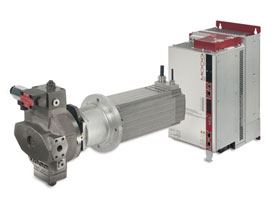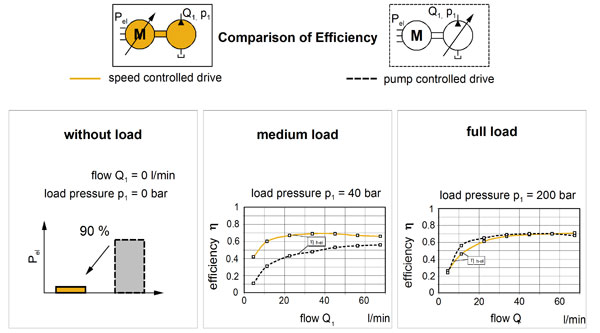Working with a variety of customers in many demanding industries gives Moog's engineers a unique opportunity to learn about issues that are concerning today's machine builders. The two we hear most often is the need for energy efficiency and how to lower total cost of ownership. These were the key drivers behind the latest innovative development Moog has recently launched into the marketplace - the Speed Controlled Pump System (Moog SCP System). This article discusses our experience with testing this system on a customer's hydraulic machine and the impressive energy savings experienced in the application. This test represented a good example of an application for hydraulic control where the need for energy efficiency is growing globally and the cost pressures are high.
Application Needs
The conventional hydraulic system for an industrial machine consists of a variable displacement pump and an induction motor which is directly connected to the power grid. In this typical system, the motor runs at a constant speed, normally at 1,500 to 1,800 rpm, and uses the internal mechanism to change the output flow of the pump. In this system there are substantial energy losses in the induction motor and in the adjustment mechanism of the pump, particularly when the system is working under partial load or working in standby mode.
For industrial machine builders, increasing energy prices and the need for environmental awareness are strong drivers prompting end users to request machines that are high performance but also with lower energy consumption, reduced total cost of ownership and improved environmental conditions such as sound emission levels.
Energy Savings with the Moog Speed Controlled Pump System
Moog's SCP system consists of integrated building block products including a dual displacement Radial Piston Pump (RKP), the Maximum Dynamic Brushless Servo Motor and the Modular Multi-Axis Programmable Motion Control Servo Drive (MSD). The key functionality it offers users is the ability for them to change the speed of the motor and pump and enable control of fluid flow.
Working with our customer we found the system was able to optimize energy efficiency on their machines. The energy efficiency of the machine with the SCP system was higher, especially when the machine works under partial load. With a medium load, the efficiency is 20 to 30% higher compared with a traditional system. When a machine is running without load, or in a standby mode, energy consumption is even up to 90% less. Under full load conditions, the performance compared to the variable displacement system is nearly identical.
Efficiency Diagrams
A Flexible System with Many Innovations
While the concept behind the system is not new, Moog was able to innovate on the technology for a few key reasons. The primary building blocks are all designed and manufactured by Moog, allowing our engineers to optimize their performance in an integrated system. For example, the MSD Servo Drive provides control algorithms that work seamlessly with our high-efficiency, low-leakage pump technology. It provides pressure and flow control functionality and provides the required torque and speed settings depending on pressure and flow demand values.
Another important innovation in the system is the dual displacement pump design, which allows the pump to operate between two displacements. This functionality is especially important if the application has a load-holding phase where the machine needs low flow, but high pressure. With a dual displacement pump design, it's possible to switch to the lower displacement, which requires a reduced torque. And as a result, the motor size required for the system can be reduced and this leads to energy savings due to the more efficient operation of the motor.
Dual Displacement Design
Comparison to Conventional Technology
In addition to energy savings, the SCP system offers the advantages of a more compact design and easier system integration. The package is more compact as the size of a synchronous motor is much smaller than the corresponding size of the induction motor. Integration is more straightforward when compared to traditional systems where the fieldbus communication is interfaced through the pump control because it is linked to the automation system. In the SCP system the fieldbus is through the servo drive electronics, similar to the configuration in an electromechanical axis, making it easier to integrate.
The Moog SCP also can be designed with a submerged installation of the motor and pump inside of the tank, taking advantage of the heat dissipating fluid in tank and further reducing the size required for the motor and requiring no extra motor cooling arrangements. As a submerged installation requires a smaller footprint, the machine designer is able to optimize the machine size. In addition, the level of sound emission of a submerged version can be significantly reduced, no suction and leakage lines are required and external leakage from pump is no longer an issue.
Conclusion
This Moog Speed Controlled pump solution can be considered for a range of applications using variable displacement pumps today. Some obvious candidates that can benefit from the energy efficiency advantages include die casting, injection molding and wrapping or bending machines. Whenever the focus of the application is on energy savings, compact design or easier integration, this new technology provides an attractive solution.
When comparing the cost of this new system with a conventional system that uses a variable displacement pump and a constant speed induction motor, it is important to consider the total cost of ownership. Even if the initial cost will be higher, our calculations and tests on customer machines show that the total cost of ownership is significantly lower. Typically after two years, the sizable energy savings will more than make up for the higher initial investment.
If you think the new Moog Speed Controlled Pump System offers an interesting new option for your machine, contact your local Moog office to learn more. We always welcome the feedback of our customers and other industry experts to help advance motion control technology in industrial machines.
Related Link: New Moog Speed Controlled Pump System Cuts Energy Use in Hydraulic Industrial Machines
Authors
Achim Helbig has been with Moog since 2004 in the position of Senior Applications Engineer, Team Manager Hydraulic Systems and Innovation Projects Manager. Prior joining Moog he has worked in the Dresden University where he completed his PhD.
Robert Luong is Product Marketing Manager for Moog with more than 15 years of experience. He specializes in the areas of competitive intelligence and product marketing, with an emphasis on price management and product positioning. His technical background includes technical sales, applications and systems engineering consultancies.
Contributors
Peter Lillqvist joined Moog Finland as Application Engineer in 1999 and worked as a System Sales Engineer since 2001. He worked as the Area Manager Finland from 2005 to 2008 when he moved to Moog in Germany as Senior Applications Engineer. Peter holds a MSc degree in Automation Engineering from the University of Tampere.
Werner Haendle has worked for Moog since 2001 as a Senior Systems Engineer. He has over 20 years of experience in hydraulics and he studied Mechanical Engineering and Controls.



